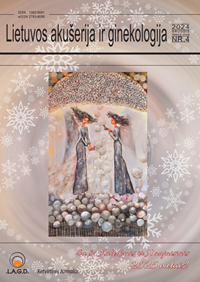POSTPARTUM DEPRESSION AND RELATED RISK FACTORS
Abstract
The aim. To evaluate the frequency of postpartum depression symptoms among patients who gave birth at VULSK, using the Edinburgh Postnatal Depression Scale, and to analyse which factors are associated with the risk of postpartum depression. Methods. An anonymous questionnaire survey was conducted at the VULSK Obstetrics Department from October to December 2023. Women were provided with a questionnaire within the first three days after childbirth, which included the 10-item Edinburgh Postnatal Depression Scale. One month after birth, the same women filled out the Edinburgh Postnatal Depression Scale questionnaire again. Results. 13.4% of women had moderate and 14% severe postpartum depression symptoms. One month later, 8% showed moderate and 27.6% severe levels of depression symptoms. It was found that factors such as first pregnancy and childbirth, younger age, depression during pregnancy, a history of depression, mental health disorders in the family, multiple pregnancies, and the newborn’s health complications were associated with a stronger manifestation of postpartum depression. In contrast, satisfaction with the partner relationship was associated with lower levels of depression. Conclusions. About a third of the women participating in the study exhibited moderate or strong symptoms of depression after childbirth and one month postpartum. Identified risk factors for postpartum depression included being a first-time mother, younger age, depression during pregnancy, a history of depression, family mental health disorders, multiple pregnancies, and health issues with the newborn.

